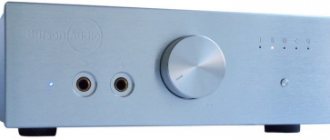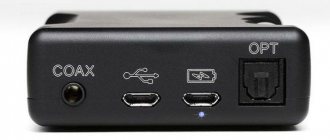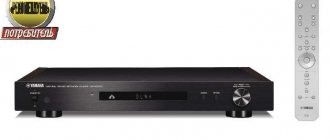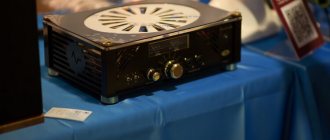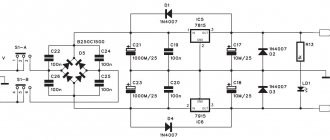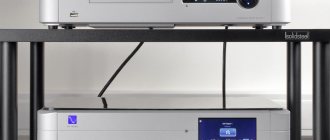Peculiarities
Burson Audio headphone amplifier
Its pedigree is easily deduced:
first there was the Soloist amplifier
, then its “lightweight” version SL, which has now turned into an improved modification of the Mk2.
The Soloist SL
, a rare Burson component that we were not able to test in our tests, differed from the original Soloist amplifier in its smaller dimensions, simplified case, and reorganized circuitry, which included a weaker power supply and an output stage with half the number of transistors.
Hence the reduction in power from 4 to 2 watts. Burson designers initially positioned the Soloist SL
as the most affordable headphone amplifier in the company's lineup.
The new version of the Mk2 retains its place in the Burson hierarchy, despite the fact that the modern Australian model range has noticeably changed. The same Soloist is no longer produced, and its position as an advanced headphone amplifier with a pre-stage output has been transferred to the Conductor Virtuoso V2
.
This version of a multifunctional device without an SPDIF/USB digital-to-analog converter can later be upgraded with digital boards to the full CV2+ version, which we talked about in a recent test review
.
from the new volume knob in the design of older Conductor Virtuoso devices
What is the difference between the Soloist SL and the new Mk2 variant? Right off the bat, two main points can be highlighted. The first difference is cosmetic - the volume knob is machined from aluminum, similar in shape to that used in Burson components from the Conductor Virtuoso family. However, if older devices use a discrete volume switch made on a Burr-Brown PGA2310 chip, Soloist SL
are equipped with a regular potentiometer, but of good quality - Japanese ALPS 20KAx2.
The second difference concerns the power supply, equipped with a reinforced 30 VA transformer. Its use increased the output power of the amplifier by a quarter, reaching 2.5 W with a 16-ohm load. Burson
engineers emphasize that they do not mean peak, but long-term power.
In addition, it was possible to reduce the output impedance of the amplifier to 3 Ohms, improving its damping factor. In general, the updated Soloist SL Mk2
will now work better with power-hungry and “low-impedance” headphones.
the Soloist SL Mk2 design story.
We could conclude by referring to the review of the first version of the SL amplifier.
But, again, it wasn’t present in our tests, so we’ll catch up in this review. Soloist SL Mk2
amplifier is made in a metal case with a rather thick, machined front panel. Of course, there is no fundamentality of the cases of older models, the wall thickness of which starts from 6 mm and reaches 1 cm on the facade. The SL Mk2 case is made more modestly: a 6-mm facade, a 2-mm aluminum profile on the chassis and rear wall, and a 1.5-mm lid on the top and sides of the device. There are no ventilation holes in the case; the solid metal present does a good job of dissipating heat, making the case itself a large radiator. And the modest size of the amplifier (80x140x210 mm HxWxD) fits perfectly into the format of desktop devices.
Soloist SL Mk2 faceplate design
, as usual with Burson components, is concise. There is a volume knob in the center, a 6.4 mm headphone jack on the left, two small buttons and two pairs of orange LEDs on the right. The top button selects one of two analog inputs, the bottom switches two gain levels of the VOS (Variable Output Stage) system. Accordingly, the rear panel is stingy on connectors, where the power socket is adjacent to two stereo RCA inputs.
Alps potentiometer volume control
new transformer and traditional components:
Elna buffer capacitors and complementary transistors A1930/C5171
Under the “hood” of the amplifier we see the traditional discreteness of Burson
, the circuits are made up of “audiophile” components such as Dale resistors, specialized Elna capacitors, Bourns trimmers and Toshiba transistors. For buffering, the power supply uses two capacitors with a capacity of 8200 μF; in the amplification sections, in addition to proprietary Australian op-amp assemblies, complementary pairs of A1930/C5171 transistors are used (3 pairs in total, two of which are used in the output stage).
Burson Audio Soloist SL MkII headphone amplifier
Building the right ear amplifier is not as easy as it might seem. As a rule, headphones have a much higher sound resolution than acoustic systems, and interference, distortion and other shortcomings of the reproducing path are clearly audible in them. And when external noises are muffled, our hearing becomes terribly picky about them.
Understanding this, the Australian company Burson Audio has developed its own design principles, which, by the way, apply to the entire range of products. First of all, this is the use of discrete transistors both on the signal path and in power stabilizers, plus a careful selection of components to build the most transparent audio path. An individual approach to each project is the basis of the ideology that Burson Audio engineers have adhered to since 1996. That is why the company develops its own discrete operational amplifiers with increased overload capacity, low noise and distortion. Along with “super stabilizers,” they are produced as separate units for tweaking audio equipment from other manufacturers.
The Soloist SL MkII amplifier is an improved version of the popular Soloist SL model. This is a compact but heavy device in a thick-walled silver aluminum housing. The “analog” volume control is the Japanese ALPS Blue Velvet, known to all upgrade lovers. There are two linear inputs, they are switched with a small button on the right. The second button sets the gain - 12 or 18 dB for headphones with different impedances.
Rich timbres, excellent attack, lack of coloration and phenomenal resolution at any listening volume.
Particular attention is paid to the quality of food. There is a solid power transformer with a large power reserve, Schottky diodes in the rectifier and Elna Silmic II smoothing capacitors. The same audiophile capacitances are installed in the sound path in combination with WIMA FKP2 film, silver mica and Dale RNC resistors with a tolerance of 1%. These components are considered the most neutral for sound, but compared to Chinese consumer goods they have a big drawback - their high price.
Of course, the amplifier does not contain any microcircuits - it is built on transistors of different structures and assembled on a printed circuit board with an additional coating that prevents oxidation of the conductive paths. The rejection of standard operational amplifiers (even those with VERY high performance) is motivated by the fact that when several dozen transistors are located on one tiny chip, it is impossible to avoid crosstalk and unwanted interactions along the power supply circuits. That is why the installation of the amplifier is free, without miniature SMD elements, due to which high temperature stability is also achieved. The undistorted power of the output stages operating in class “A” is 2.5 W with a load resistance of 16 Ohms. With the high sensitivity of modern headphones, it is more than enough even for fans of very loud music. The operating range starts from 0 Hz, i.e. we are dealing with a DC amplifier capable of reproducing any infra-low frequencies present in the recording.
There is a solid power transformer with a large power reserve, Schottky diodes in the rectifier and Elna Silmic II smoothing capacitors.
For Soloist testing, three headphone models with different impedances were selected - Sennheiser HD800 (300 Ohm), Phonon SMB-02 (40 Ohm) and Final Sonorous X (16 Ohm). Of course, when assessing the qualitative potential of an amplifier, adjustments were made for the individual characteristics of their sound. The signal was supplied from the line output of the well-known Naim CD5 XS CD player.
First, a light load (in terms of output current), but requiring increased amplification - Sennheiser HD800 (RUB 64,900). If you turn off the source and turn the volume control to maximum, you can hear no noise or background - the complete impression is that the amplifier is not working at all. In music, the tonal balance, traditionally for older Zenns, is noticeably brightened - the bass is present, and it is really low, but it clearly lacks “meat”. But the lower mids and highs, right up to the edge of the audible range, are simply magnificent. Rich timbres, excellent attack, lack of coloration and phenomenal resolution at any volume. The amplifier operates with maximum output voltage, but no distortion, no compression, or any other defects can be heard. The resulting spatial picture is very interesting - with localization and several perspective plans. Phase errors in the path are minimal. Yes, these are very high-end headphones, and the amplifier is no worse than them.
Next in line are the 40-ohm Phonon SMB-02, closed Japanese stereo phones of a strong mid-range (30,000 rubles). The bass is crazy, the kick drum hits your eardrums, the drive is simply killer. After the Sennheisers the balance seems to have shifted downwards, but this feeling only lasts for a few minutes. Excellent overall dynamics, although the resolution in the upper spectrum is much lower. However, for rock and other energetic genres this is exactly what you need. And again - an excellent stereo picture with a clear separation of plans, and not the slightest distortion.
Open middle, powerful energy and precise musical balance across a variety of genres.
Finally, the highlight of the program, the Final Sonorous X super headphones (439 thousand rubles). With a resistance of 16 Ohms, the load is already comparable to speaker systems, but the Soloist SL MkII specifications stipulate this value. Interestingly, the amplifier is an order of magnitude cheaper than headphones and, nevertheless, allows them to fully reveal their character. There is a powerful, delicately crafted bass, a juicy, not overdried blow, and a detailed top with an airy halo of ultrasonic components. Open middle, powerful energy and precise musical balance across a variety of genres. The strings now have characteristic metallic vibrations that can be heard during live performance.
Accordingly, the bottom line: Soloist SL MkII is able to simplify the choice of an amplifier/headphone combination, since its own influence can not be taken into account at all, but can be focused solely on the search for a suitable second link.
Soloist SL MkII
Manufacturer: Burson Audio (Australia)
www.bursonaudio.com
Output Power (RMS, 16 ohms): 2.5 W || Total Harmonic Distortion (30 Ohm, 1 W): <0.03% || Signal-to-noise ratio: > 96 dB || Frequency range (± 1 dB): 0 Hz - 50 kHz || Gain (LO/HI): 12/18 dB || Channel Separation: >73 dB || Input impedance: 30 kOhm || Output Impedance (1W): 3 Ohms || Inputs: 2 x RCA || Output: 6.3mm headphone || Power consumption: 23 W || Dimensions (W x H x D): 140 x 80 x 210 mm || Weight: 2.5 kg || Price: 44925 rub.
COMPONENTS
- Naim CD5 XS CD player
- Headphones: Final Sonorous X 16
- Phonon SMB-02 40
- Sennheiser HD800 300
MUSIC
- Corelli, “Concerti Grossi Op.6. Volume 2". Opus 111, France, 1996
- The Manhattan Transfer, "Tonin'". Atlantic, 1994.
- Pink Floyd, Division Bell. EMI/Pink Floyd Music 1994
- Muddy Waters, "King of the Electric Blues". Legacy Records, 1997
share
Tags: Burson AudioFinal SonorousNaimPhononSennheiserSoloist
Impression
AUDIO SYSTEM COMPONENTS
Headphones: Sennheiser HD650, Focal Spirit Classic USB cable: QED Digital USB Amplifier/DAC: Burson Audio Conductor Virtuoso V2+ Interconnect cables: Nordost Blue Heaven
Although Soloist SL Mk2
and occupies the lowest rung in the range of
Burson
, it demonstrates the sound of a serious class.
The even tonal balance of playback is accompanied by the strong and clear bass, so beloved by Berson fans, as well as a well-developed mid and top. The presentation is natural and fairly neutral, showing no noticeable warm or cool tones coloring the sound. The amplifier conveys dynamic contrasts and a rich palette of timbres well, although, in fairness, we note that in terms of the thinnest micro-amplitude layers of music, it slightly limits the information content of the sound. But on the other side of the dynamic range, the Soloist SL Mk2
plays energetically and uninhibitedly, delighting with fast, collected bass and refined highs. Sound articulation at mid frequencies is also not satisfactory. Despite the rather bright manner of playback, the amplifier perfectly feels the degree of comfort, avoiding harshness and annoying assertiveness. Loud bursts from large groups of instruments do not spoil the intelligibility of timbres and do not affect the spatial rendering of the image. The uppermost octaves with overtone tails and cymbal trails are somewhat darkened, so the music scene slightly loses the airiness and contrast of the separation of instruments in large orchestral compositions. The stage, on the one hand, is not very wide in azimuth, but it perfectly outlines the depth of the hall, neatly distributing instruments in different echelons. Bass instruments are well localized in the background. In general, the amplifier manages to correctly build a musical composition even in difficult cases with rich instrumentation and score.
Comparing Soloist SL Mk2
With the new top-end amplifier from the Australians
Conductor Virtuoso V2
, which doubles the purchase price, you can notice that the younger amplifier sounds a little simpler and more schematic, losing a little to its older brother in timbre nuances, volume and depiction of the musical scene.
In general, the very fast sound of the SL Mk2 in terms of attack and resolution of time transitions is slightly inferior to its ancestor Soloist and other Burson amplifiers of previous versions, equipped with a proprietary volume control on discrete resistors. The reproduction detail comparison here is about the same as between the "big" Conductor components and their lightweight Conductor SL
equipped with Alps potentiometers.
But in terms of expressive sound, Soloist SL Mk2 looks even more interesting than CV2. The younger amplifier sounds brighter: less attention to nuances, but more drive. This curious fact is clearly demonstrated by a combination of amplifiers with honest and balanced, but rather “tight” Focal Spirit Classic headphones for uninhibited dynamics. With CV2, the headphones sounded very natural and accurate, but without emotional fire. The audio system from Soloist SL Mk2
with the same headphones sounded with a spark, not so airy, smooth and transparent, but pumping up the sound with enviable energy.
